Tourism is one of the biggest industries in the Philippines, contributing 8.6% of gross domestic product (GDP) in 2023. Though dampened by the 2020 COVID-19 pandemic, the Philippines’ tourism industry is gradually recovering, opening up new opportunities for domestic and foreign investors.
Tourism is closely linked to infrastructure development, and government and commercial institutions are investing heavily in it in the Philippines. This infrastructure boom was kickstarted by the “Build! Build! Build! (BBB)” program under former President Rodrigo Duterte, which earmarked $165 billion for public works projects.
Under current President Bongbong Marcos, the Build! Build! Build! program has been replaced by the Build Better More (BBM) program. Government officials pitched the BBM program as an expansion of the previous infrastructure program, earmarking more investment for public works.
A recovering, fast-growing tourism industry and an infrastructure boom provide many investment opportunities. Investors can take advantage of new infrastructure, such as airports, roads, water, and seaports, to develop tourism projects that were not previously feasible.
Let’s explore the infrastructure projects driving the Philippines’ boom, the trends in the tourism industry, and how they intersect to open up new investment opportunities.
INFRASTRUCTURE PROJECTS
In 2017, then Philippines President Rodrigo Duterte launched the Build! Build! Build! (BBB) program to address the country’s significant infrastructure gap and encourage economic growth. This project earmarked $165 billion over five years for public works projects, including airports, public transport, seaports, water, and power supply.
The Philippine government partnered with commercial firms to co-develop some projects under the BBB program. By 2022, when Duterte stepped down as President, a dozen f lagship projects, including the Clark International Airport expansion and Metro Rail Transit Line 3 Rehabilitation, had been completed.
President Bongbong Marcos assumed office in 2022 and unveiled an expanded infrastructure program, the Build Better More (BBM). This program earmarked another $164 billion over six years for flagship infrastructure projects, including those conceived by the previous Duterte administration.
The BBM program’s goal was clear: the Philippines has significant infrastructural deficits, and major funding is required to close that gap. The government will lead the way, and commercial investors will follow to augment these projects. The new infrastructure projects will open more opportunities for industrialization, which leads to higher domestic economic output, and tourism, which boosts foreign income.
A recovering, fast-growing tourism industry and an infrastructure boom provide many investment opportunities
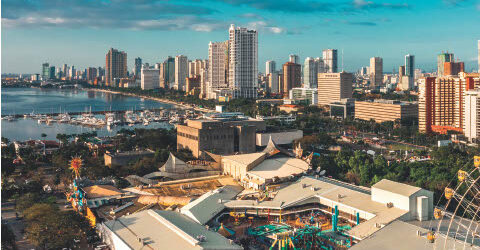
Two major projects under the BBM program include:
• Metro Manila Subway
Manila, the Philippines’ capital, and its surrounding metro areas have a population of nearly 15 million. It is the world’s most densely populated area, with 111,000 people per square mile. This large population and density naturally lead to congestion problems.
In 2023, Manila topped the TomTom Traffic Index list with the worst metro area traffic. Congestion is a common problem experienced by locals and tourists, and public transport is one effective way to tackle it.
The Metro Manila Subway is a $4 billion+ project funded mainly by a loan from the Japanese government. This underground rapid transit line is currently under construction and will stretch 33 kilometers with 17 stations across the Manila metro area. It will be integrated with Metro Manila’s existing public transit system, enabling passengers to access road-based public transport from subway stations to their final destinations.
Once completed, the Metro Manila Subway, with an expected daily ridership of 400,000 to 800,000 people, will significantly reduce traffic congestion. Reduced congestion translates to a greater quality of life for locals and tourists, spurring increased foreign visits as the Philippines recovers from the COVID-19 pandemic travel slump.
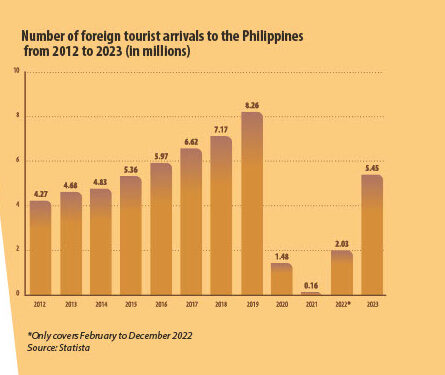
• New Manila International Airport
Construction is ongoing on a new international airport that will reduce congestion at the Ninoy Aquino International Airport (NAIA), the main airport serving Manila and its surrounding Metro areas.
Once completed, the Metro Manila Subway, with an expected daily ridership of 400,000 to 800,000 people, will significantly reduce traffic congestion
The aptly named New Manila International Airport is being constructed on a coastal area 35 km north of Manila. It is planned for an initial capacity of 35 million passengers, expandable to 100 million. Though initially planned to open in 2026, construction delays have pushed back the $13 billion project to 2028.
Notably, this project is handled by a domestic conglomerate, the San Miguel Corporation, with no government guarantees or subsidies. It illustrates how private investors can profit from the Philippines’ long-term economic growth.
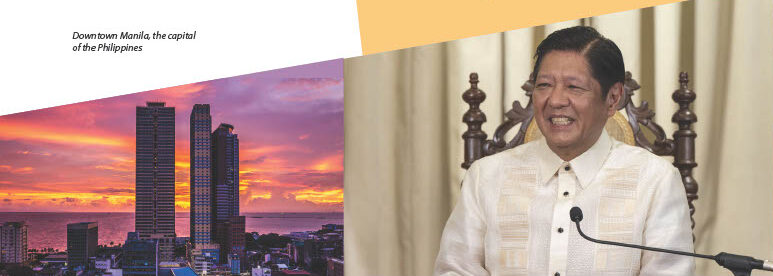
Ninoy Aquino International Airport (NAIA), Manila’s main airport, is severely congested. In 2019, before the COVID-19 pandemic, it handled 48 million annual passengers, well above its 33 million capacity.
The New Manila International Airport will ease pressure on the NAIA, providing travelers with more convenient experiences and encouraging more foreign visits. It’ll help usher in the Philippines’ tourism sector growth, which investors can leverage to make profits.
DEVELOPMENT OF THE TOURISM SECTOR
Tourism is one of the Philippines’ main economic sectors. It contributes significantly to the country’s GDP, foreign exchange market, and global economic standing.
• Recovery after the COVID-19 pandemic
The Philippines received 5.45 million tourists in 2023, up from 2 million in 2022 and 1.5 million in 2020, the year after the COVID-19 pandemic. Although the sector hasn’t recovered to its pre-pandemic high of 8.3 million foreign arrivals, it’s rebounding significantly and creating new investment opportunities.
The Philippines expects to receive 6 million foreign visitors in 2024 and 9.7 million by 2028, well above the pre-pandemic 8.2 million record.
• Ecotourism and the natural landscape of the Philippines
Ecotourism is a driving force behind the recovery of the Philippines’ tourism industry. Ecotourism refers to nature-oriented tourism aimed at conserving the natural environment and interpreting the natural world. Though conventional tourism still dominates, ecotourism is a nascent space with opportunities for investors to build formidable, sustainable businesses.
With its numerous beaches, diving spots, wildlife, volcanoes, and other natural wonders, the Philippines is well-positioned to build on the ecotourism boom.
• Contribution of the hospitality and restaurant industries to GDP
The hospitality and restaurant sectors are central to the Philippine tourism industry. Tourists stay at hotels and often want to try local foods, so restaurants and hospitality always track the tourism industry’s growth.
Employment in the Philippine hospitality industry has grown from 4.6 million in 2020 to 6.2 million in 2023. It hasn’t reached its pre-pandemic record of 7 million, but it’s on track to bounce back.
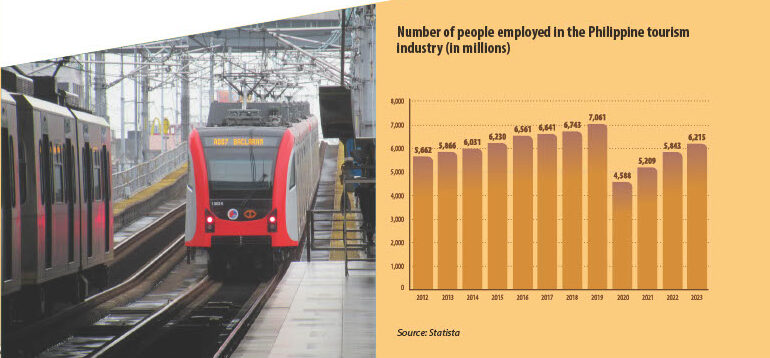
Hospitality investors can look to the Philippines as a key growth driver. Numerous opportunities exist for lodging, event planning, theme parks, travel agencies, food and beverage suppliers, restaurants, nightclubs, and bars.
Some hospitality firms exited the Philippines during the COVID-19 pandemic and haven’t returned. These exits created a void that new investors, especially hotel developers, could fill.
Foreign brands can partner with local developers to create long-lasting brands. The Philippine tourism sector is set to boom in the ensuing years, and investors shouldn’t overlook this boom.
RISKS AND CHALLENGES
Though booming, the Philippines’ tourism industry has its fair share of risks and challenges; these risks are mainly environmental and growing tourism competition from other Southeast Asian countries.
• Environmental challenges
The Philippines’ vast natural landscape is a mixed blessing. It makes the country a tourist magnet but leaves it vulnerable to environmental changes.
Climate change has increased the intensity of the Philippines’ natural hazards, including typhoons, extreme rainfall, droughts, and sea level rise. These hazards can damage infrastructure and livelihoods, risking economic development.
In 2023, tropical cyclones caused 18 billion Philippine pesos ($309 million) in damages, and earthquakes caused 2.8 billion pesos ($48 million). Fortunately, the fatalities caused by natural disasters have declined since 2013, as the Philippine government increased its disaster mitigation expenditure to a record 108 billion pesos ($1.9 billion) in 2022 and similarly high amounts in the following years.
Adapting new and existing infrastructure to climate change is central to the Philippines’ economic growth. Public transport, buildings, airports, seaports, water supply, and more must be resilient against environmental changes, requiring innovative construction techniques and extra funding.
Public-private partnerships are needed to secure the funds and domestic regulations to make Philippine infrastructure resilient to climate change effects. Widespread efforts are also required to reduce the country’s greenhouse gas emissions.
The government has already taken action, committing to reduce emissions by 75% in 2030, one of the most ambitious targets in Southeast Asia.
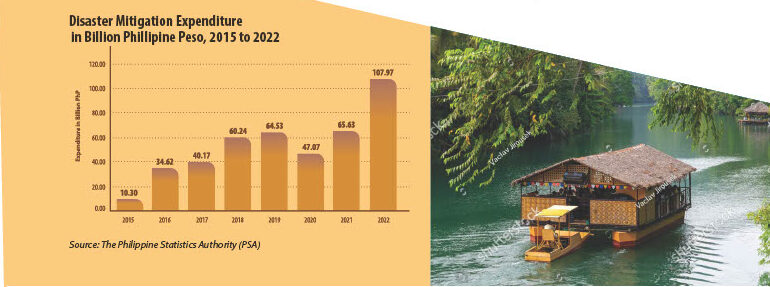
• Increasing competition in Southeast Asia
The Philippines is not the only Southeast Asian country eyeing a tourism boom. Several nearby nations, mainly Vietnam, Thailand, and Singapore, are investing heavily in infrastructure and tourism development to drive economic growth.
Thailand already holds the crown of Asia’s most visited country, with 28 million foreign visitors in 2023 and an expected 36 million in 2024. Vietnam received 12.6 million visitors in 2023, 3.5x higher than the previous year, and Singapore recorded 13.6 million tourist arrivals in 2023.
The record visits in Thailand, Singapore, and Vietnam imply increasing competition for the Philippines. These countries have created conducive environments for tourism and infrastructural development, and the Philippines needs to step up its game to compete.
The Philippine government is on the right track with its infrastructure development to create a favorable environment for tourism projects. Ecotourism is another way it can drive robust growth while competing with other Southeast Asian countries. More could be done, but these existing efforts are commendable.
THE PHILIPPINES: A HUB FOR SUSTAINABLE DEVELOPMENT
Economic trends point to the Philippines as a hub of sustainable development. The country can build on its existing tourism sector to become a global destination for sustainable infrastructure investments.
From airports and public transport to renewable energy, the Philippines provides many opportunities for investors to profit from the transition towards sustainable investments. For example, the world’s largest solar plant, with 3.5 GW of solar panels and a 4.5 GWh battery energy storage system, is currently being constructed in the Philippines, in line with the country’s pledge to reduce carbon emissions by 75%.
San Miguel Corporation, a local conglomerate, is building the New Manila International Airport. These projects exemplify the Philippines as a hub of sustainable long-term economic development. Many opportunities exist for both domestic and foreign investors.
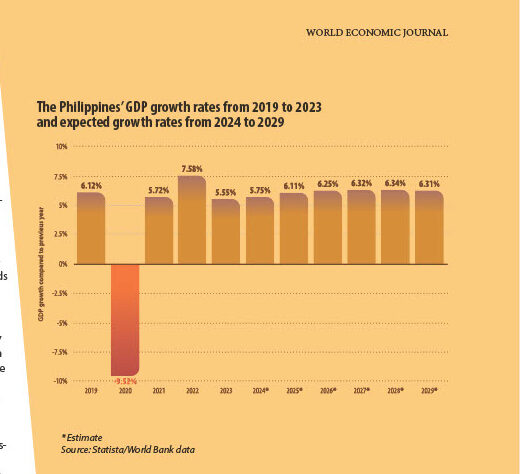
RECOMMENDATIONS FOR FOREIGN INVESTMENTS
Foreign investors targeting the Philippine market should consider infrastructure and tourism investments from a sustainability perspective. The Philippines has a substantial infrastructural deficit, including roads, energy, and public transit, which private investors can help fill. Hospitality brands can also build new lodging, events, theme parks, restaurants, bars, and similar businesses to take advantage of the Philippines’ tourism rebound.
Save for 2020, the anomaly year of the COVID-19 pandemic, the Philippine economy has grown by at least 5% annually over the past decade. This economic growth indicates the growing opportunities for foreign investors in the domestic economy.
The Philippine government has positioned the country as a sustainable development hub, and investors are welcome to capitalize on the ample investment opportunities.
By Adneissa Christy Alezy
PHOTO: CHANWIT WHANSET / STOCK.ADOBE.COM; SHUTTERSTOCK; PHOTO: PXHERE.COM; MC1 ALEXANDER KUBITZA; E911A / CC BY-SA 4.0; PHOTO: VOJO / SHUTTERSTOCK.
Stay informed anytime! Download the World Economic Journal app on the App Store and Google Play.
https://apps.apple.com/kg/app/world-economic-journal-mag/id6702013422
https://play.google.com/store/apps/details?id=com.magzter.worldeconomicjournal
https://www.magzter.com/publishers/World-Economic-Journal

